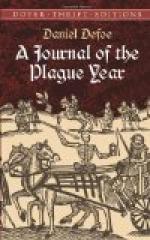They had supposed this pit would have supplied them for a month or more when they dug it; and some blamed the churchwardens for suffering such a frightful thing, telling them they were making preparations to bury the whole parish, and the like. But time made it appear, the churchwardens knew the condition of the parish better than they did: for, the pit being finished the 4th of September, I think they began to bury in it the 6th, and by the 20th, which was just two weeks, they had thrown into it eleven hundred and fourteen bodies, when they were obliged to fill it up, the bodies being then come to lie within six feet of the surface. I doubt not but there may be some ancient persons alive in the parish who can justify the fact of this, and are able to show even in what place of the churchyard the pit lay, better than I can: the mark of it also was many years to be seen in the churchyard on the surface, lying in length, parallel with the passage which goes by the west wall of the churchyard out of Houndsditch, and turns east again into Whitechapel, coming out near the Three Nuns Inn.
It was about the 10th of September that my curiosity led, or rather drove, me to go and see this pit again, when there had been near four hundred people buried in it. And I was not content to see it in the daytime, as I had done before,—for then there would have been nothing to have been seen but the loose earth, for all the bodies that were thrown in were immediately covered with earth by those they called the “buriers,” which at other times were called “bearers,”—but I resolved to go in the night, and see some of them thrown in.
There was a strict order to prevent people coming to those pits, and that was only to prevent infection. But after some time that order was more necessary; for people that were infected and near their end, and delirious also, would run to those pits wrapped in blankets, or rugs, and throw themselves in, and, as they said, “bury themselves.” I cannot say that the officers suffered any willingly to lie there; but I have heard that in a great pit in Finsbury, in the parish of Cripplegate (it lying open then to the fields, for it was not then walled about), many came and threw themselves in, and expired there, before they threw any earth upon them; and that when they came to bury others, and found them there, they were quite dead, though not cold.
This may serve a little to describe the dreadful condition of that day, though it is impossible to say anything that is able to give a true idea of it to those who did not see it, other than this: that it was indeed very, very, very dreadful, and such as no tongue can express.




